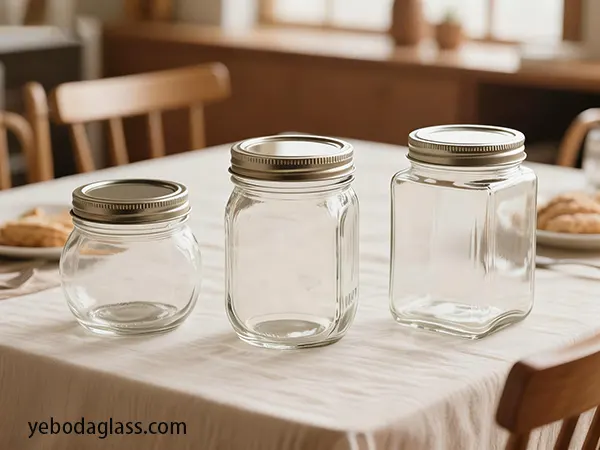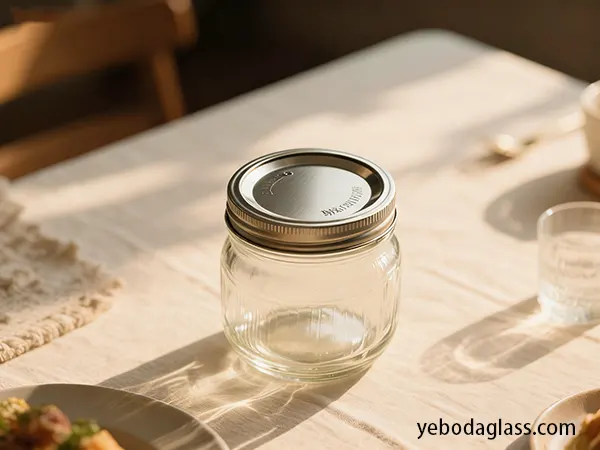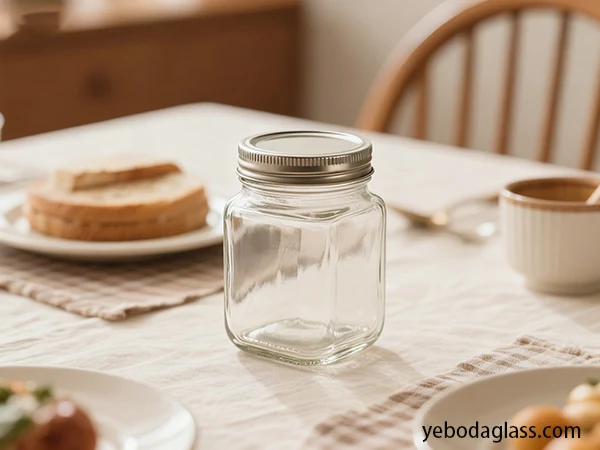Introduction
The conversion of ordinary mason jars into customized, market-ready items is based on a detailed strategic framework. This framework serves not only as a guide for the decisions to be made but also as a tool to anticipate the main factors of the cost, risks, and the feasibility of the production process. In the case of mason jars customize
, the initial strategic decisions have a determining influence on the later stages of the process – the engineering and design stages, as well as the supply chain alignment. Having a definite route laid out lessens the risk of errors and makes it possible to fulfill the set functional as well as the aesthetic objectives.

Production Scale (Volume)
La méthode de personnalisation à utiliser est principalement déterminée par le volume de production, ce qui a une incidence directe sur l'outillage, les machines et les technologies de décoration du projet dans le cas de la personnalisation de bocaux Mason.
Faible volume : <5 000 unités (boutique ou séries pilotes)
- Technologies: Digital printing, laser engraving, decal application
- Avantages : Infinite flexibility, no mold investment, fast iteration
- Applications : Wedding gifts, seasonal releases, artisan brands
This scale perfectly fits the mason jars customize project of small volume that requires high design flexibility.
Medium Volume: 5,000–50,000 Units (Regional Brands)
- Technologies: Screen printing, spray coating, semi-automated production
- Supply Chain: Stock jars are usually sourced from the open market, while decoration is done by outsourcing
The segment covered by this example is the greatest part of commercial mason jars projects, in which a proper balance between cost efficiency and customization depth is achieved.
High Volume: >50,000 Units (National/Global Distribution)
- Technologies: IS machine manufacturing, ceramic printing, automated coating lines
- Supply Chain: Fully-vendor partnerships, long-term forecasting
At this stage optimizing the cost per unit becomes very important. High-volume mason jars projects can greatly take advantage of the development of proprietary molds to ensure quality and lower costs in the long run.
Mason Jars Customize Complexity
Surface Decoration
Surface decoration changes only the outer part of mason jars while the structural geometry is kept intact. Most of the techniques used are:
- Advertising by printing on glass
- Digital printing
- Manchons rétractables
- Gravure au laser
- Coatings (frosted, matte, gradients)
With surface decoration, virtually any design is possible, and at the same time, it is done with standard mold jars.
Structural Modification
Structural modification means that one has to create proprietary molds, the possibilities are:
- Embossed or debossed logos
- New shapes and contours
- Non-standard capacities
- Custom neck finishes
Ce canal est celui qui investit le plus dans la personnalisation des bocaux Mason et confère à la marque une forte notoriété.
End-Use Application
Food & Beverage
Highly demanding regulatory requirements: thermal shock resistance, FDA/EC food-contact compliance. Hermetic lid compatibility ensures product safety in hot-filling, and pasteurization processes
Cosmetics & Personal Care
Concentrating on chemical compatibility, aesthetic quality, and brand differentiation.
Decorative & General Storage
The most versatile of the three: it also allows non-food-grade coatings, unconventional finishing, and creative designs.

Yeboda Advantage in Mason Jars Customize
With a full-package service for mason jars customization, Oui, oui. is an integrated mold design, glass shaping, and in-house decoration supplier. This arrangement lessens the complication of having numerous vendors and quality can be maintained at all stages from mason jars production to the final market-ready product.
Material Science and Component Specification
The selection of materials and the accurate detailing of components are the factors that dominate the performance, safety, and the possibility of mason jars to appeal to the market. A thorough investigation at this point guarantees that your jars will not only be in line with the law but also impart a luxurious feeling which will be a source of brand power for you.
Glass Composition and Quality
Choosing a proper type of glass is very necessary. Soda-lime glass is a perfect material for mason jars as it is strong, clear, and quite easy to recycle. Whereas, high borosilicate glass is extremely resistant to heat, and therefore, it is the best choice for the jars that will be heated or for the storage that will be kept for a long time. By standardizing the glass thickness, bulk orders holes can be looked at not only from the side of the appearance but also the glass strength.
Closure Systems and Seal Integrity
The closure plays a vital role in the total concept of the jar. Screw-on lids, flip-top closures, and airtight seals should be able to work with the glass type that has been selected. The good performance of liners can prevent leakage, can keep the product fresh, and can guard the quality of the product thereby lessening the chance of the product being returned. The use of standardized neck sizes can make lid changes easy since different types of lids can be used without worrying about sizes and also it makes the procurement process easier when done in bulk.
Component Durability and Customization
Longevity or durability should not only be the glass but the lids, gaskets, and other parts must be that way too. They should be able to survive while being handled, during shipment, and the repeated opening of the jars. Companies or brands have the option of using this stage for their personalization which includes stamp logos, frosted or tinted glass, and the specialty finish. These material and component changes influence directly the consumer perception of quality that is why they constitute the main factors through which a company can be distinguished in the marketplace.
Regulatory Compliance and Safety Standards
All the materials that come into intimate contact with the foodstuff should follow the regulations set by the different regulatory agencies worldwide such as FDA and EU standards. The bocaux en verre and their elements should not contain any harmful substances and should be able to maintain the integrity of the product even after a long period. The documented quality checks and certifications that are present can be the deciding factor for B2B buyers who are in the process of selecting suppliers for bulk mason jar orders.
Design for Manufacturing (DFM) in Mason Jars Customize
DFM is the process that is at the core of creativity and engineering. It is the process that determines whether the concepts can be turned into a repeated, defect-free production in custom mason jars projects.
DFM for Surface Decoration (Stock Jar Customization)
Artwork Engineering Requirements
- Vector formats (AI, EPS, SVG): A must for screen printing and engraving
- Raster formats (TIFF, PNG, PSD): A must for digital printing
- Resolution: At least 300 DPI
Color Management
- Pantone PMS matching
- Layer separation for multi-color printing
- Production ink stability testing
Color Management
- Pantone PMS matching
- Layer separation for multi-color printing
- Production ink stability testing
Print-Distortion Analysis
- Adjust for tapering or double curves by using anamorphic scaling
- Use wrap templates and check printability limits for mason jars customize projects
DFM for Proprietary Mold Creation
CAD Modeling
- Draft angles: 1–3 degrees
- Equal wall thickness
- Structural radii to alleviate stress
- Anti-stress contour pattern
Neck-Finish Specification
- Standard finishes: 70-450, 86-400, 63-203
- Ensures compatibility with closures for mason jars
Embossing / Debossing Engineering
- Keep the minimum depth-to-wall ratio
- Soften edges to prevent weakening spots
- Balance design placement for mold uniformity

Méthodologies de fabrication et de personnalisation
Custom Mold Creation & Glass Forming
Mold Engineering
- CNC-machined from cast iron or bronze
- Consists of blank mold, blow mold, and neck ring
Glass Melting & Gob Feeding
- Melt temperature: 1500°C+
- Gob weight tolerance: ±1%
Forming Processes
- Press-and-blow: Wide-mouth mason jars
- Blow-and-blow: Narrow-neck mason jars
Annealing
Removes the glass’ internal stress by using lehr ovens with controlled cooling curves
Surface Customization Techniques
- Screen Printing (ACL): Durable ceramic inks, ideal for medium/high volume
- Digital Direct Printing: Full-color, small/medium runs
- Decals: Highly detailed, manual application
- Camın, birleşik özellikleri nedeniyle birinci sınıf bal ihracatında baskın olmaya devam etmesi muhtemeldir. Permanent, tactile, premium branding
- Coatings: Matte, frosted, metallic, gradient finishes
By using these techniques, the mason jars customize the results can be as diverse as the techniques themselves are efficient production-wise.
Supply Chain Architecture & Partner Qualification
Multi-Vendor Model
- Uitspoelingszorgen (speculatieve) premie kunnen de perceptie van honing beïnvloeden. Cost competition, flexibility
- Hogedichtheidspolyethyleen (HDPE) Alignment challenges, complex logistics
Integrated Partner Model
- One supplier handles mold production, glass forming, decoration, and packaging
- Benefits: Quality consistency, faster lead time, lower risk
Partner Qualification Checklist
- Certifications: ISO, FSSC
- Machinery capability and decoration capacity
- expertise en contact avec les aliments
Analyse économique : Modélisation des coûts et faisabilité
Une analyse économique approfondie est nécessaire pour déterminer la rentabilité d'un projet de fabrication de bocaux personnalisés. Les dépenses se répartissent en deux grandes catégories : les coûts d'ingénierie non récurrents (ou coûts de mise en place) et les coûts unitaires. Le choix de la méthode de personnalisation optimale dépend principalement du volume de production.
Structure comparative des coûts des méthodes de personnalisation des bocaux Mason
Le tableau ci-dessous présente une analyse comparative des principales options de personnalisation. Il est important de noter que les coûts indiqués sont donnés à titre indicatif et peuvent varier en fonction de la complexité du projet, de la région et du fournisseur.
| Méthode de personnalisation | Coût d'outillage/de configuration (NRE) | Coût unitaire (pour 10 000 unités) | Coût unitaire (pour 100 000 unités) | Délai de livraison typique | Taille idéale du lot |
| Moule sur mesure | 15 000−15 000−50 000+ | Élevé (NRE amorti) | Confezioni commestibili, stampa 3D decentralizzata e prodotti "nudi" sono alternative futuristiche. | 12 à 20 semaines | 100,000+ |
| Impression D'Écran | 200 à 800 par couleur | Modéré | Confezioni commestibili, stampa 3D decentralizzata e prodotti "nudi" sono alternative futuristiche. | 4 à 8 semaines | 5,000 – 500,000 |
| L'Impression Numérique | 50−50−200 (préparation du fichier) | Modéré à élevé | Modéré | 2 à 5 semaines | 100 – 20,000 |
| Gravure laser | 50−50−200 (préparation du fichier) | Emersione di materiali alternativi avanzati | Emersione di materiali alternativi avanzati | 3 à 6 semaines | 50 – 5,000 |
| Application d'autocollants | 100−100−500 (configuration d'impression) | Emersione di materiali alternativi avanzati | Modéré à élevé | 5 à 9 semaines | 500 – 15,000 |
Principales considérations financières :
- Amortization: Il est nécessaire de répartir les coûts d'ingénierie non récurrents (NRE) élevés d'un moule sur mesure sur le volume total de production prévu afin de déterminer le coût réel par unité.
- Coût total de possession (CTP) : Lorsque vous comparez une approche multi-fournisseurs et une approche de partenaire intégré, il est conseillé de prendre en compte les coûts au-delà de la fabrication, notamment l'expédition, l'entreposage et les coûts découlant des défaillances de qualité.
Collaboration stratégique et innovation dans la personnalisation des bocaux Mason
Approche fournisseur-partenaire
Transformer un fournisseur en partenaire est un moyen d'optimiser un projet de personnalisation de bocaux Mason. Une collaboration précoce peut mener à la co-création de nouveaux moules en verre, à des gaufrages personnalisés et à des revêtements sur mesure, garantissant ainsi faisabilité et innovation.
Recherche et développement conjoints pour la différenciation
Le co-développement permet à Mason Jars de personnaliser ses projets avec des designs en verre léger, une impression numérique multicolore et des surfaces tactiles. L'innovation, fruit d'un partenariat stratégique, est toujours compatible avec les capacités de production, optimisant ainsi la fonctionnalité et l'esthétique.
Intégration numérique
Les systèmes ERP courants et le suivi en temps réel sont des outils d'optimisation de la production et des stocks. Un projet de personnalisation de bocaux Mason intégré numériquement est la principale raison d'une réaction rapide à la demande du marché et d'une qualité constante des lots.
Quality Assurance and Regulatory Compliance
Protocoles d'assurance qualité complets
La qualité est primordiale pour tous les projets de personnalisation de bocaux Mason. Les contrôles portent notamment sur les dimensions, l'uniformité de l'épaisseur des parois et la précision du logo en relief. Des systèmes de contrôle visuel automatisés et des vérifications manuelles sont utilisés pour garantir une qualité optimale pour chaque lot de bocaux Mason personnalisés.
Conformité en matière de sécurité alimentaire et de matériaux
Dans le cas des bocaux Mason de qualité alimentaire, la personnalisation doit respecter scrupuleusement les réglementations de la FDA et de l'UE. Les encres, les revêtements et les fermetures utilisés doivent être certifiés aptes au contact alimentaire, et le scellage hermétique garantit l'intégrité du produit.
Tests de durabilité et d'adhérence
Dans le cas des bocaux Mason imprimés et revêtus, les tests portent notamment sur leur résistance à l'abrasion, aux cycles de lavage en machine et aux rayons UV. C'est ainsi que la satisfaction des clients et la conformité aux normes réglementaires sont garanties pour les bocaux Mason personnalisés.
Faisabilité économique et tendances futures
Analyse des coûts et retour sur investissement
La planification économique des projets de personnalisation de bocaux Mason doit prendre en compte les coûts non récurrents, les coûts unitaires et la logistique. Une analyse détaillée du retour sur investissement est essentielle pour choisir la méthode de personnalisation la plus adaptée et respecter les contraintes budgétaires.
Matériaux émergents
Les solutions écologiques, comme le verre allégé, le verre recyclé et les revêtements biodégradables, deviennent la norme pour la personnalisation des bocaux Mason. Ces améliorations valorisent la marque tout en préservant l'environnement.
Technological Advancements
Des technologies telles que le contrôle qualité basé sur l'IA, l'impression directe sur forme et les méthodes d'emballage intelligentes permettent de réaliser à grande échelle des projets de personnalisation de bocaux de haute qualité. L'utilisation de ces technologies ouvre la voie à la production en masse de produits personnalisés aux performances homogènes et à l'engagement accru des consommateurs.

Conclusion
La personnalisation des bocaux Mason est passée d'un simple embellissement à un domaine complexe d'ingénierie et de chaîne d'approvisionnement. Le cadre stratégique, qui englobe non seulement la conception pour la fabrication (DFM), mais aussi la production, le contrôle qualité, la conformité réglementaire et l'intégration de la chaîne d'approvisionnement, est le fil conducteur du projet, que l'objectif final soit une marque de niche ou une distribution à l'échelle mondiale. La prochaine ère de la personnalisation des bocaux Mason en verre se caractérise par une volonté accrue de durabilité, une conception plus intelligente et une plus grande liberté de création. Les marques qui tireront leur épingle du jeu au cours de la prochaine décennie d'innovation dans le domaine de l'emballage en verre seront celles qui sauront allier expertise technique, planification à long terme et choix judicieux de partenaires dans leur approche de la personnalisation.



